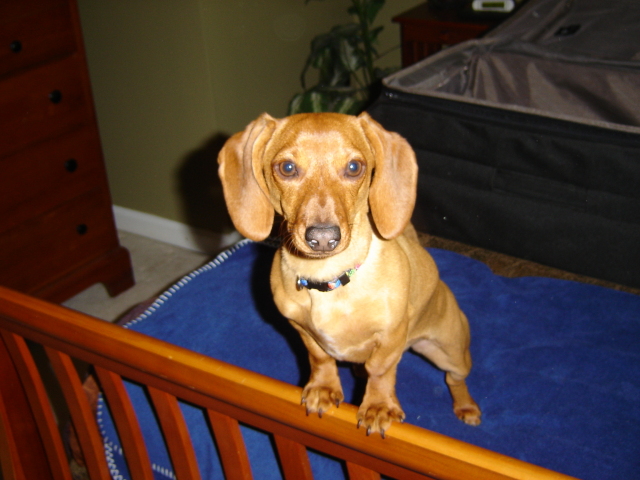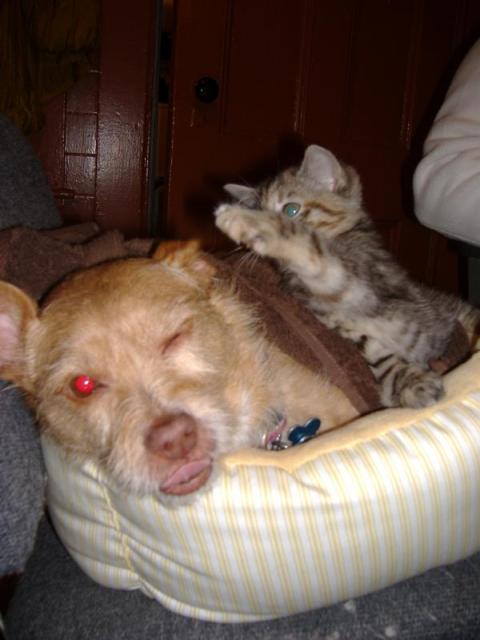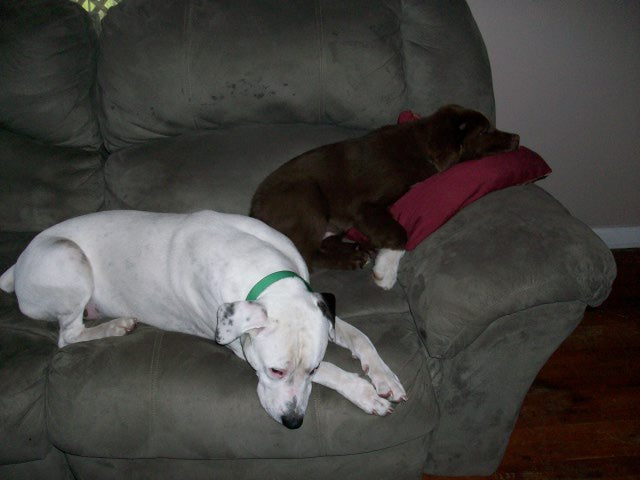QuestionHello,
I am in desperate need of help with a dog who is approximately one year old. He is a Chihuahua mix who was recently rescued from a hoarding situation. I believe he may have been abused as well. I say this because I took him outside for a walk (with my dog) and then let him go in my fenced in back yard to see if he would play with my dog (who was also a rescue) and he ran right under my porch and hid. When I pulled him out gently and brushed off his back very lightly (he had a little sand on it) he cowered. I have been talking to him and petting him in his kennel but he stays in there all the time. My dog pretty much ignores him as do my cats. He eats only in the kennel and when you try to take him out for a walk he tries to get to the back of the kennel as far as he can. He is extremely fearful and will poop or pee if you have too much contact with him. Very timid and very fearful walking. He really does break my heart. I took him around the block for a walk and when some children came up to us he pooped, peed and just about lost his mind wanting to run away. I really need to socialize him so that he can get adopted one day. The rate this is going (1 month) I worry if anything will help. He seems so scarred. I am not giving up on this little guy. He deserves love and a good home. Please help. I am going to contact a local trainer to see if he can help with some hands on techniques. When do you think a dog possibly needs anti-anxiety meds? Just something I was thinking about. Haven't broached my vet on the subject yet. Thank you
AnswerThis dog needs a certified applied animal behaviorist, NOT a dog trainer. STAY AWAY from dog trainers.
An adult dog from a situation where he has seen nothing, met no one, been nowhere, is going to take MONTHS of careful rehabilitation. This can't be done in weeks: MONTHS (perhaps longer). While medication might help to calm him, there are side effects to most of those drugs and some of those side effects are heightened anxiety and even aggression. Proceed with caution.
DO NOT flood this dog by taking him places where there are lots of people, other dogs, traffic, etc. He is unable to withstand this amount of stimuli and it is worsening his fear. DO NOT drag him out of the crate. Leave a trail of tiny treats (small tidbits of hot dog) to urge him out of his crate voluntarily. Keep a house tab on him (leash with handle cut off) when you are at home so you can pick up the house tab to lead him outdoors once he is out of the crate. CHILDREN are out of the question and my guess would be this is for the remainder of this dog's life. YOU CANNOT SOCIALIZE HIM. He's in no shape for it. Desensitization to fearful stimuli must be done quite carefully and slowly and is sometimes impossible to obtain. Often, the most you can do is build new associations between the dog and the feared objects, very, very slowly and under expert guidance.
Not every dog is a candidate for a new home. When we do "rescue" we have to do it with the knowledge that some dog we give haven to will NOT be able to leave. This dog has had a horrific existence, he was most likely totally ignored, his interaction with other dogs may have been fearful (because of his natural timidity). He doesn't understand what humans ARE (he was not habituated to humans as created conspecifics) and he does not understand restraint (hugs), touch, or even kind words. He needs expert evaluation. See the sites below for a professional in or near your area. Once evaluated, the dog may well be a candidate for medication but ONLY after serious evaluation and then quite cautiously:
http://certifiedanimalbehaviorist.com/page6.html
http://www.animalbehavior.org/ABSAppliedBehavior/caab-directory
http://www.arkanimals.com/ark/dg_expert_referrals.html
Meanwhile: give the dog space and plenty of time to habituate to you and his new surroundings. Do not make direct eye contact. Do not bend over him or attempt to pick him up. Read body signals so you can see what he's thinking and responding to:
http://veterinarynews.dvm360.com/dvm/article/articleDetail.jsp?id=94404
http://www.canis.no/rugaas/index.php
Leave little trains of tiny goodies (like Hansel and Gretel lol) when he's around you so he associates reward with your presence. Don't hesitate to repost using followup feature (so I can see your original question and my answer to it) with further questions. Who knows, this little guy could turn out to be a gem, but he is going to need time.

 Mini Daschund with anxiety issues
QuestionAbigayle
QUESTION: I have a 3 1/2 yr old
Mini Daschund with anxiety issues
QuestionAbigayle
QUESTION: I have a 3 1/2 yr old
 My dog is shaking and hiding under my bed recently
QuestionRorrie and Pencil
QUESTION: My dog, Rorr
My dog is shaking and hiding under my bed recently
QuestionRorrie and Pencil
QUESTION: My dog, Rorr
 Dog light and shadow chasing
Question
Jenni
My 3 year old Cavalier King Charles Span
Dog light and shadow chasing
Question
Jenni
My 3 year old Cavalier King Charles Span
 Agressive 1 yr old mini goldendoodle
Question
our millie
My husband and I got our min
Agressive 1 yr old mini goldendoodle
Question
our millie
My husband and I got our min
 American Bulldog aggression
Question
Buddy and Rez
I have a 2 year old Ameri
American Bulldog aggression
Question
Buddy and Rez
I have a 2 year old Ameri